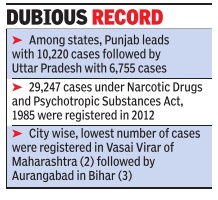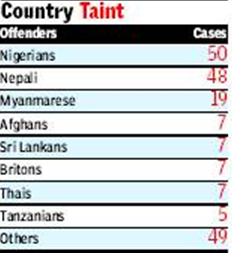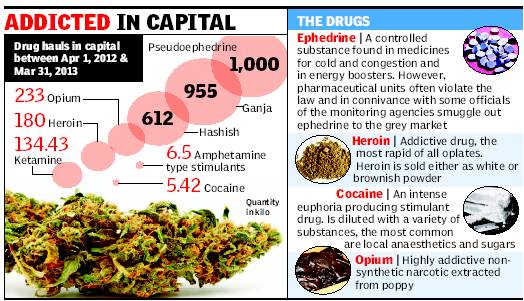Drugs/ Narcotics: India
(→Narcotics) |
|||
| Line 84: | Line 84: | ||
NCB also asked agencies to crack down on abuse of prescription drugs with the smuggling of codeine-based Phensedyl increasing across borders. | NCB also asked agencies to crack down on abuse of prescription drugs with the smuggling of codeine-based Phensedyl increasing across borders. | ||
| − | + | =Curbs by four EU nations= | |
| − | + | [http://epaperbeta.timesofindia.com/Article.aspx?eid=31808&articlexml=4-EU-nations-put-curbs-on-25-drugs-07122014014029''The Times of India''] | |
| + | December 07 2014 | ||
Four European countries decided to suspend marketing authorization of 25 drugs, which had undergone tests at the GVK Biosciences facility | Four European countries decided to suspend marketing authorization of 25 drugs, which had undergone tests at the GVK Biosciences facility | ||
Revision as of 05:59, 12 December 2014
This is a collection of articles archived for the excellence of their content. Readers will be able to edit existing articles and post new articles directly |
Contents |
Cities with the highest drug trafficking: 2012
With 1,512 cases, Mum tops in drug trafficking
Delhi Second With 829 Cases: NCRB
The Times of India Jun 23 2014
Of the over 50 Indian cities which reported maximum cases of drug trafficking in 2012, the national capital is at the second spot behind Mumbai while Punjab leads among states followed by Uttar Pradesh, indicates National Crime Record Bureau (NCRB) data.
Citing comprehensive data available for 2012, the NCRB said Mumbai registered maximum cases of drug trafficking at 1,512 followed by Delhi with 829 cases therefore leading the group of 53 Indian cities that are highly active when it comes to drug trade.
Data for 2013 is yet to be compiled.
Delhi is followed by Kanpur (Uttar Pradesh) with 551 cases, Amritsar with 457, and Kota (Rajasthan), with 242 cases. Meanwhile, the lowest number of cases were registered in Vasai Virar of Maharashtra (2), followed by Aurangabad in Bihar (3), Dhanbad and Ranchi (4 each) and Vadodara and Rajkot (5 each). A total of 29,247 cases under Narcotic Drugs and Psychotropic Substances Act, 1985, were registered in 2012 compared to previous year’s 29,048 cases.
As per the state wise NCRB data, Punjab has emerged at the top position with 10,220 registered cases in 2012 followed by UP with 6,755 cases, Maharashtra, 1,903 cases, Tamil Nadu, 1,402 cases and Rajasthan with 1,115 cases.
J&K registered 411 cases while Gujarat, despite sharing its border with Pakistan, which is major supplier of narcotics, registered only 68 cases.
The lowest number of cases were reported from Sikkim (3) followed by Andaman and Nicobar Islands (4), Puducherry (6) and Lakshadweep (11).
The data further said a total of 13,459 people, including 216 foreigners, were arrested and 89,519 kg of drugs including opium, morphine, heroin, ganja, hashish, cocaine, methaqualone, ephedrine, LSD, acetic anhydride, and amphetamine were recovered. IANS
Drug trade: Nigerians top list of foreigners held in drug trade
Jayaraj Sivan | TNN 09
Chennai: Every third foreign national arrested for drug-related offences in the country last year was from Africa and every fourth from Nigeria alone. Neighbouring Nepal (48 arrests), which didn’t lag far behind either, along with Nigeria, accounted for almost 50% of the total 199 arrests of foreigners effected for drug offences. Mynamarese form the third biggest chunk on the list with 19 arrests. Foreigners are, however, hugely outnumbered by locals in the trade. For every foreigner arrested, 99 Indians were also picked up, according to the 2008 annual report of the Narcotics Control Bureau (NCB) released recently.
African drug syndicates pose a major challenge to drug enforcement agencies in India, primarily because of their trans-national links. Located within reach of the South American cocaine belt, West African nationals, especially Nigerians, play a decisive role in the drug’s trafficking. Often, cartels prey on the African diaspora. ‘‘Many, who come to India as students or businessmen, unwittingly bump into drug smugglers when people of the same nationality meet. Lured by the prospect of quick money, some of them fall into the trap. We’ve come across many first-time offenders among Africans,’’ said south zone director of NCB, S Davidson Devasirvatham.
Apart from Nigerians arrested last year (50), other African nationals who figured on the Indian drug radar are Tanzanians (5), Zambians and South Africans (3 each), Kenyans and citizens of Ivory Coast (two each) and one each from Cameroon, Uganda, Congo and Liberia. Barring Zambia, India doesn’t have a bilateral agreement or memorandum of understanding on sharing information on drugrelated crimes with any of these African nations.
While Africans take heroin out of the country, they bring cocaine back into India to exploit its potential as a recreation drug in metros like Delhi and Mumbai and some tourist destinations, says NCB director general OPS Malik in the report. A total of 50 seizures adding up to 12 kg of cocaine, which has a street price of Rs 3,000 per line of 0.5 gram, was made across Indian cities last year.
The most preferred modusoperandi is to send the contraband through ‘‘post or courier parcels’’ and ‘‘human mules’’, mainly women from South East Asian countries. A large number of locals are also used. This modus operandi gives the advantage of anonymity to the actual kingpins and makes it difficult for investigating agencies to trace the masterminds of the trade. It also ensures that seizures don’t leave a financial dent on the traffickers’ operating costs.
A senior police officer said, ‘‘We have information that several Nigerians who were involved in SMS and e-mail lottery frauds had used the booty for the narcotics trade. This helps them operate virtually without any capital investment.’’
Although the number of arrested foreigners went up from 181 to 199 between 2007 and 2008, there is no perceivable long-term trend as regards their involvement in the overall trade of narcotics in the country. In 2006, 232 foreigners were arrested as the trade saw a sudden spurt in the involvement of foreign nationals in drug trafficking, but the number fell the next year, only to go up again in 2008.
African nationals concentrate primarily on the traditional trafficking route of heroin — from Pakistan to India through western borders.
Narcotics
Delhi transit hub in narcotics corridor
Dwaipayan Ghosh TNN
New Delhi: Data released by Narcotics Control Bureau on International Day Against Drug Abuse has once again shown how Delhi is rapidly emerging as a transit point of high-end drugs smuggled by international cartels.
While the capital lags behind other states in use of ganja and opium, it ranks high in consumption of party drugs such as ketamine and cocaine. Maharashtra is the top consumer of party drugs, according to this data. Between April 1, 2012 and March 31, 2013, a total of 143.43kg ketamine has been seized in Delhi compared to Maharashtra (2,170kg) and Tamil Nadu (596kg). Ketamine is produced illegally in the latter states for supply to southeast Asian countries. The fact that Delhi ranks three on the list when it is not even a major producer indicates it is a transit point. Police said this is due to its unique location between producers Afghanistan and Commonwealth of Independent States nations and consumers in southeast Asia.
According to top officers in the narcotics wing and NCB officials, pseudoephedrine—used to make party drugs like ‘Speed’ and ‘Ecstasy’—is a good example of a transit drug. The total seizure of pseudoephedrine in the past one year in north, east and northeast India have been more than 4,500kg.
The figures also include a cocaine haul of 5,429kg and 180kg heroin. The cocaine circuit is dominated by African cartels who also engage in heroin trade. But most of the heroin seized in the capital are of southwest Asian origin and enters India through Pakistan border, says an NCB study.
Security agencies have long believed that some of the money in this trade is actually a portion of narco-terrorism wherein profits from selling this drug is used to fund terror activities. A total of 612.08kg hashish, 955.58kg ganja and 233.42kg opium were also seized from the capital in this one year. A new item on the list is ATS (amphetamine-type stimulants). Over 6.5kg ATS was seized in the city vis-à-vis Maharashtra (40kg).
“It is believed that, due to establishment of special ATS labs, some foreign operatives are using the country’s huge chemical base to source raw materials and produce such drugs. Drug hauls on Delhi-Manipur route show they are being trafficked to Myanmar,” the NCB noted.
“Recent seizures of Kolkatabound consignments in eastern and northern India indicate that the mafia is using West Bengal's ports to smuggle banned drugs to South America. A group of pharmaceutical companies are handing out stocks from Uttarakhand. This is then brought to Delhi en route to northeast, Myanmar and Thailand. The processing is completed in factories there before the drugs are pushed backed to India. While a portion returns to party circles in Delhi and Mumbai, the rest is shipped out to Colombia and Uruguay where these drugs are in high demand,” said an NCB official.
NCB also asked agencies to crack down on abuse of prescription drugs with the smuggling of codeine-based Phensedyl increasing across borders.
Curbs by four EU nations
The Times of India December 07 2014
Four European countries decided to suspend marketing authorization of 25 drugs, which had undergone tests at the GVK Biosciences facility European Medicines Agency (EMA) did say in a statement that it is reviewing the findings of non-compliance with good clinical practice at the GVK facility and determining its impact on medicines authorized on the basis of studies performed there. Germany , France, Luxembourg and Belgium have already decided to suspend marketing authorizations of these drugs. EMA's Committee for Medicinal Products for Human Use (CHMP) is now identifying, together with member states of the EU, the medicines covered by the inspection findings. French drug regulator ANSM has said on its website that Belgium, Germany , Luxembourg and France decided to suspend the marketing authorizations for the medicinal products concerned. “Although these documents are not essential to the demonstration of bioequivalence, the ANSM decided, as a precaution, to suspend the marketing authorization of 25 marketed generic drugs.


